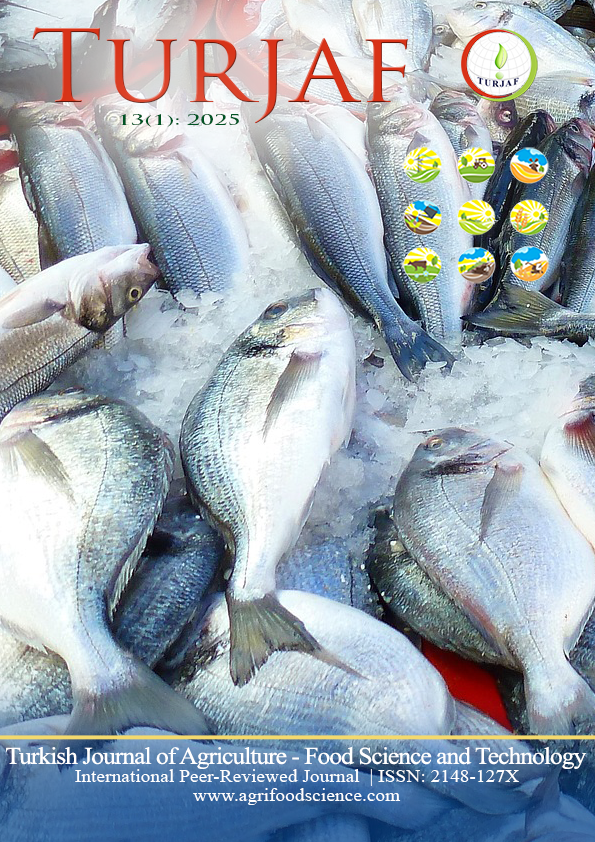Frozen Food Consumption Habits of Working Women
DOI:
https://doi.org/10.24925/turjaf.v13i1.78-85.7362Keywords:
Working women, frozen food, consumption habits, attitudes and behaviors, NutritionAbstract
The aim of this study was to evaluate the frozen food consumption habits of working women in 19 Mayıs district of Samsun province. The study was conducted with 200 working women. Actively working individuals who volunteered to participate in the study were included in the study. Body weight and height of the individuals were measured. Body mass index (BMI) was calculated using body weight and height. In the results of the study, 76.0% of the individuals consumed frozen foods while 24.0% did not. Among the frozen food groups, meat and meat products, fruits and vegetables, and pastries are consumed more, respectively. The reasons for purchasing frozen foods were as follows: 41.4% of the individuals stated that they purchased frozen foods because of saving time, 48.0% because of ease of preparation, 6.6% because they were influenced by advertisements, and 18.4% because of seasonal differences. When the reasons why individuals do not buy it are analyzed, 25.0% find the price high, 33.3% believe that it is healthy, 33.3% state that it is not fresh and 4.2% think that it is not satisfying. When the type of consumption was analyzed, 61.8% stated that they consumed it as a side dish, 42.8% as an appetizer, and 17.1% as a main dish. Among family members, individuals between the ages of 15-30 consume frozen food the most. A statistically significant difference was found between the age, marital status, and education of the individuals participating in the study according to whether they consume frozen food or not. Overall, frozen foods can be a convenient and practical option for working individuals and families, offering a balance between convenience, nutrition and taste. However, it is necessary to pay attention to safe labeling, storage conditions, amount and method of consumption of frozen foods.
References
Coulomb, D. Refrigeration and cold chain serving the global food industry and creating a better future: Two key IIR challenges for improved health and environment. (2008). Trends in Food Science & Technology, 19 (8):413–7. https://doi:10.1016/j.tifs.2008.03.006.
Zhu, Z., Zhang, P., Sun, DW. (2020). Effects of multi-frequency ultrasound on freezing rates and quality attributes of potatoes. Ultrasonics Sonochemistry, 60:104733. https://doi.org/10.1016/j.ultsonch.2019.104733
Chen, Q., Zhang, Y., Y. Guo, Y., Cheng, H., Qian, W., Yao, Y. et al. (2020). Non-destructive prediction of texture of frozen/thaw raw beef by Raman spectroscopy. Journal of Food Engineering, 266:109693. https://doi.org/10.1016/j.jfoodeng.2019.109693
Li, L., Pegg, RB., Eitenmiller, RR., Chun, JY., Kerrihard, AL. (2017). Selected nutrient analyses of fresh, fresh-stored, and frozen fruits and vegetables, Journal of Food Composition and Analysis, Vol 59, Pages 8-17. https://doi.org/10.1016/j.jfca.2017.02.002
Sen, S., Antara, N., Sen S. (2021). Factors influencing consumers’ to Take Ready-made Frozen Food. Current Psychology, 40:2634–2643. https://doi.org/10.1007/s12144-019-00201-4
Mohan Kathuria, L., Gill, P. (2013). Purchase of branded commodity food products: Empirical evidence from India. British Food Journal, 115(9), 1255–1280. https://doi.org/10.1108/BFJ-08-2011-0209
Muktawat, P., Varma, N. (2013). Impact of ready to eat food taken by single living male and female. International Journal of Scientific and Research Publications, 3(11), 1–3.
Patel, D., Rathod, R. (2017). Ready-to-eat food perception, food preferences and food choice–a theoretical discussion. Worldwide Journal of Multidisciplinary Research and Development, 3(8), 198–205. http://dx.doi.org/10.2139/ssrn.4975357
Jaafar, SN., Lalp, PE., Naba, MM. (2012). Consumers’ perceptions, attitudes and purchase intention towards private label food products in Malaysia. Asian Journal of Business and Management Sciences, 2(8), 73–90.
Ayaz, A., Bilici, S. (2008). Çalışan ve Çalışmayan Kadınların Besinleri Satın Alma, Hazırlama ve Pişirme Konusundaki Bilgi ve Davranışları. J Nutr and Diet, 35(2):31-46.
Arıkan, B., Şanlıer, N. (2000). Ankara’da üç farklı sosyo-ekonomik düzeydeki semtlerde yaşayan kadınların dondurulmuş hazır besinleri saklama, kullanma ve evde besinleri dondurma durumlarının saptanması üzerine bir araştırma. III. Uluslararası Beslenme ve Diyetetik Kongresi, 12-15 Nisan, Ankara.
Yıldız, S. (2019). Üniversite Öğrencilerinin Dondurulmuş Gıda Tüketim Akışkanlıklarının Belirlenmesi. Tekirdağ Namık Kemal Üniversitesi Yüksek Lisans Tezi.
Külekçi, M., Topaloğlu, A., Aksoy, A. (2006). Dondurulmuş Gıda Tüketimini Etkileyen Sosyo-Ekonomik Özelliklerin Belirlenmesi. Erzurum İli Örneği. Atatürk Üniversitesi Ziraat Fakültesi Dergisi, 37 (1): 91-101.
Demirel, EY. (2017). Dondurulmuş Gıda Tüketimini Etkileyen Sosyo-Ekonomik Faktörlerin İncelenmesi: Akdeniz Üniversitesi Örneği. Yayınlanmamış Yüksek Lisans Tezi, Akdeniz Üniversitesi Sosyal Bilimler Enstitüsü, Antalya.
Gündüz, O., Emir, M. (2010). Dondurulmuş Gıda Tüketimini Etkileyen Faktörlerin Analizi: Samsun İli Örneği. HR. Ü.Z.F. Dergisi, 14 (3): 15-24.
Korkmaz, N. (2011). Kültürel Farklılıkların Dondurulmuş Gıda Tüketim Kalıplarına Etkisi: Polonya-Türkiye Karşılaştırması. Sakarya Üniversitesi, Sosyal Bilimler Enstitüsü, Yüksek Lisans Tezi, Sakarya.
Özer, B. (2013). Adana İli Merkez İlçelerinde Tüketicilerin Dondurulmuş Gıda Tüketim Alışkanlıkları. Yayımlanmamış Yüksek Lisans Tezi, Kahramanmaraş Sütçü İmam Üniversitesi Fen Bilimleri Enstitüsü, Kahramanmaraş.
Yatağan, F., Yalçın, G., Kart Örmeci, Ç., Demircan, V. (2015). Isparta İlinde Dondurulmuş Gıda Ürünlerine Yönelik Tüketici Tercihleri. The Journal of Food, 40 (2): 1-8. http://doi.org/10.15237/gida.GD14045.
Murphy, K.R., Myors, B. (2004). Statistical Power Analysis, a Simple and General Model for Traditional and Modern Hypothesis Test. London: Lawrence Erlbaum Associates, 55-68.
Yolsal, N., Kıyan, A., Özden, Y. (1998). Beslenme Durumunu Değerlendirmede Beden Kitle İndeksinin Kullanımı. Beslenme ve Diyet Dergisi, 27(2): 43-48.
Güngör, M. (2008). Ki-Kare Testi Üzerine. Fırat Üniversitesi Doğu Araştırmaları Dergisi, 7(1), 84-89.
Downloads
Published
How to Cite
Issue
Section
License
This work is licensed under a Creative Commons Attribution-NonCommercial 4.0 International License.









